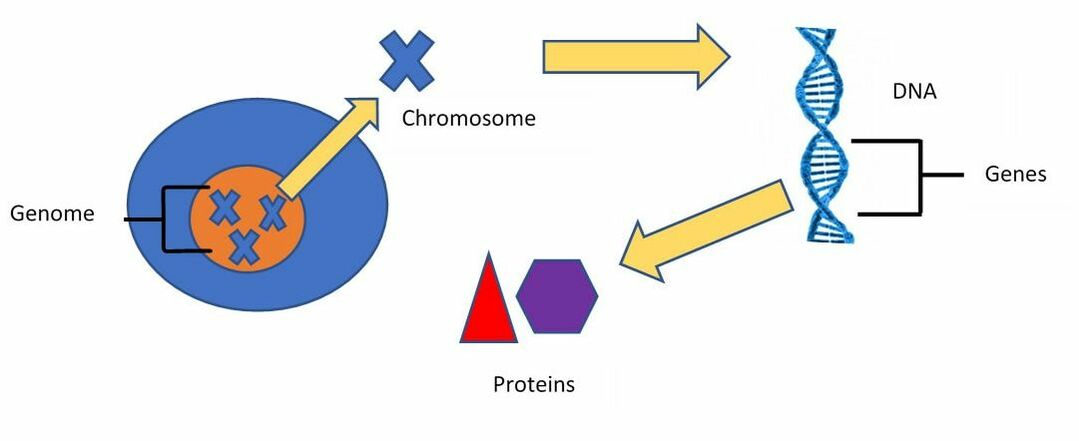|
Our genes, which are sequences of DNA or RNA, make us human. Our genes encode molecules that have specific purposes. For example, some genes encode things such as the color of our eyes or our height. Genes produce proteins that direct all the pathways in our bodies. Certain proteins, like those in our hair and skin, can be seen. However, other proteins control functions inside of our body. Throughout most of the body, every cell has the same genes. Yet, within each of the different cells, some genes are active while others are not. When active, genes can produce proteins; this process is known as gene expression.  Figure 1: Schematic diagram of a cell and its DNA. Every cell contains a nucleus, which contains its genetic material. The genome consists of all the genetic material of an organism, the majority of which is located inside the nucleus. The "X"s in the figure represent the chromosomes. The DNA, which makes up the chromosomes, contains genes which encode proteins. Of the estimated 20,000 different genes in the human genome, about one third are expressed mostly in the brain! Compared to the rest of the body, the brain has the most genes expressed. These genes impact how the brain develops and functions, and how we perceive and interact with the world. Our environment also contributes to how genes are expressed; for example, chemicals, temperature, and sunlight can all influence gene expression.
Additionally, our genes, in combination with our environment, can determine if we may develop a particular disease. Our genes can also predict how a disease may progress. Doctors can use genetic profiles to see if someone is likely to inherit a disease, even if they are not showing any signs of the disease. In the laboratory, studies are being performed using our genetic profiles to learn more about disease prevention, diagnosis, and treatment. Whenever scientists detect new genes associated with a disease, their discovery also uncovers possible targets for treatment. To learn more about genes in the brain see “Brain Basics-Genes at Work in the Brain” (NIH Publication No. 10-5475 July 2010). https://www.ninds.nih.gov/Disorders/Patient-Caregiver-Education/Genes-Work-Brain Written by Meagan Edited by Stephanie
1 Comment
TOM
2/7/2024 04:48:13 pm
Thank you for providing such an insightful and well-structured blog post. The information you shared was clear and concise, making it easy to follow along. I appreciated the additional resources and references you included for further exploration. To delve deeper into this topic, <a href="https://efa7bwqa0ogziodj76olw9mxcs.hop.clickbank.net" target="_blank">click here</a>.
Reply
Leave a Reply. |
LINKS FOR TEACHERS
AuthorLearn more about our bloggers on the "Meet Our Team" page. Archives
May 2022
Categories
All
|
|
Return to home page
|
Go to BrainReach Montreal/ Mission Cerveau
|
 RSS Feed
RSS Feed





